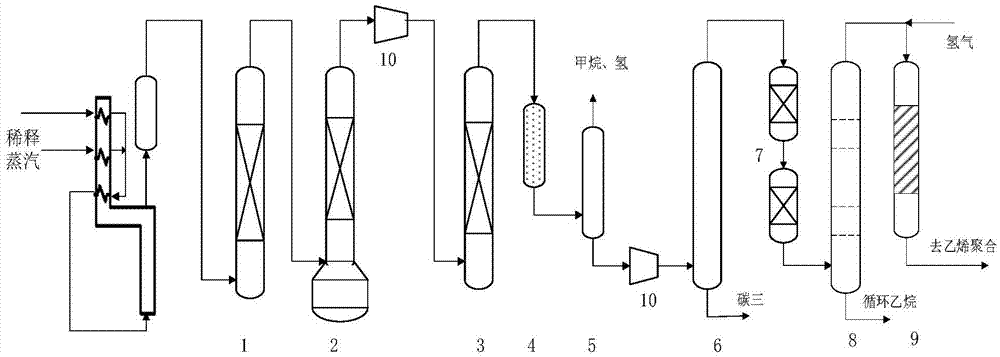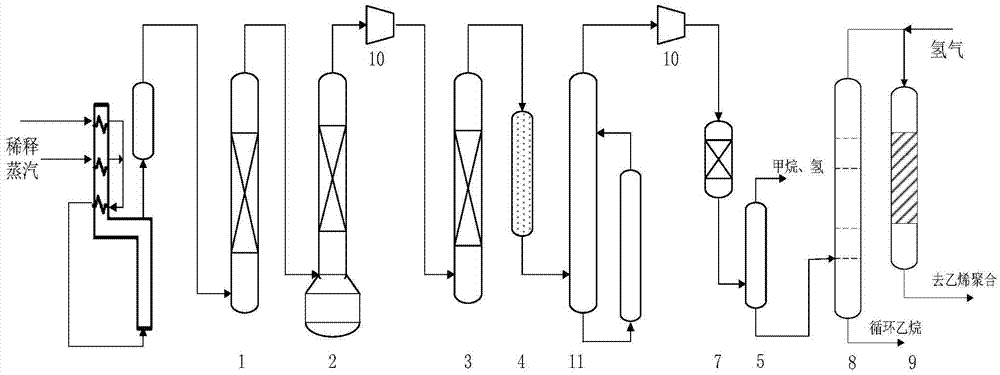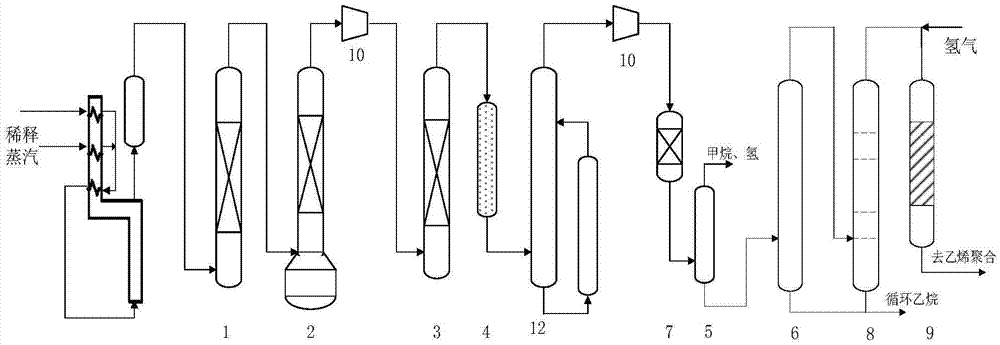Method for preparing polymer grade ethylene through hydrogenation for removing acetylene
A technology of polymerization grade and ethylene, which is applied in the field of hydrogenation and alkyne removal to produce polymer grade ethylene, can solve the problems of unfavorable industrial application, harsh conditions and high reaction temperature, and achieves excellent anti-coking performance of catalyst, low ethylene loss rate and high reaction activity. Moderate effect
- Summary
- Abstract
- Description
- Claims
- Application Information
AI Technical Summary
Problems solved by technology
Method used
Image
Examples
Embodiment 1
[0074] Weigh 100ml of a clover-shaped α-alumina carrier of Φ4.5×4.5mm, and place it in a 1000ml beaker. Take ferric nitrate, dissolve it in 60ml of deionized water by heating, adjust the pH value to 2.5, impregnate the equal volume on the surface of the carrier, shake the carrier quickly for 6 minutes, let stand for 30 minutes until the adsorption balance, and completely seal the mouth of the beaker with plastic wrap , aged in a water bath at 60°C for 30 minutes, and then in an oven according to the procedure: Dry the catalyst, move the catalyst into an evaporating dish, and activate the catalyst in a muffle furnace using a temperature-programmed method. The activation procedure: Weigh an appropriate amount of nickel nitrate, impregnate according to the above preparation steps, and dry and activate. Then tetrabutyl titanate was removed, supported by the same method as above, and the catalyst was obtained after activation.
[0075] Evaluation method:
[0076] Before the ...
Embodiment 2
[0079] At 50°C, a certain amount of NaAlO 2 solution and ZrCl 4 The solution was stirred and mixed, then neutralized with nitric acid solution, stirred for 10 hours, and uniform Al-Zr particles were formed by co-precipitation. The resultant was filtered and the Na in it was washed with deionized water + and Cl - Ions, and then add polyvinyl alcohol with a mass concentration of 15% as a pore-forming agent, kneading and molding. Dry at 130°C for 2 hours, and calcined at 650°C for 4 hours to obtain a Zr-Al composite support, the mass ratio of alumina to zirconia in the support is 4:1.
[0080] Weigh 100ml of the composite carrier and place it in a 1000ml beaker. Take ferric nitrate and nickel nitrate, heat and dissolve in 100ml deionized water, adjust the pH value to 2.0, impregnate the solution at a temperature of 80°C, impregnate the excess on the carrier, shake the beaker for 10min, filter off the excess impregnating solution, and place the catalyst in a water bath at 60°C...
Embodiment 3
[0085] Weigh 100ml of a Φ1.5mm spherical α-alumina carrier. Dissolve ferric nitrate in 40ml of deionized water, adjust the pH value to 3.0, soak the liquid at 40°C, spray it on the carrier with a watering can, load it in the drum for 10 minutes to make the active components evenly loaded, and control the loading process in 6 minutes to complete, and then In the oven follow the procedure: Dry the catalyst, move the catalyst into an evaporating dish, and use the temperature program method to activate the catalyst in a muffle furnace. Obtain a catalyst dip.
[0086] Using the same method as the first step, nickel nitrate is taken, dissolved, sprayed and dipped onto the surface of the impregnated catalyst, then dried and roasted to obtain the final catalyst. Drying procedure:
[0087] Titanium tetrachloride was taken, loaded according to the same steps as above, and calcined to obtain a catalyst.
[0088] Before the catalyst is used, it is reduced with 20% hydrogen i...
PUM
| Property | Measurement | Unit |
|---|---|---|
| Pore volume | aaaaa | aaaaa |
Abstract
Description
Claims
Application Information
 Login to View More
Login to View More - R&D Engineer
- R&D Manager
- IP Professional
- Industry Leading Data Capabilities
- Powerful AI technology
- Patent DNA Extraction
Browse by: Latest US Patents, China's latest patents, Technical Efficacy Thesaurus, Application Domain, Technology Topic, Popular Technical Reports.
© 2024 PatSnap. All rights reserved.Legal|Privacy policy|Modern Slavery Act Transparency Statement|Sitemap|About US| Contact US: help@patsnap.com










